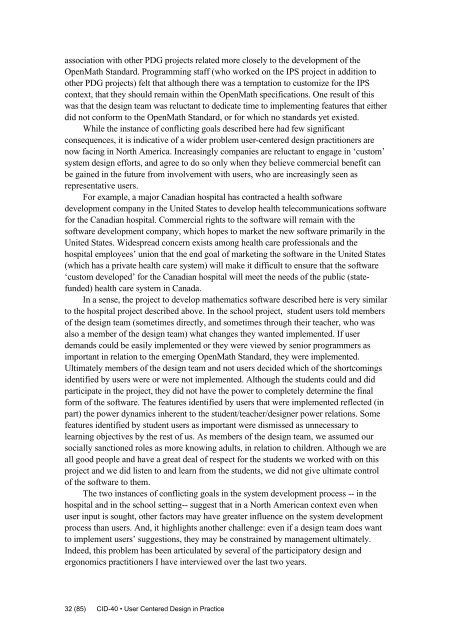User Centered Design in Practice - Problems and Possibilities
User Centered Design in Practice - Problems and Possibilities
User Centered Design in Practice - Problems and Possibilities
Create successful ePaper yourself
Turn your PDF publications into a flip-book with our unique Google optimized e-Paper software.
association with other PDG projects related more closely to the development of the<br />
OpenMath St<strong>and</strong>ard. Programm<strong>in</strong>g staff (who worked on the IPS project <strong>in</strong> addition to<br />
other PDG projects) felt that although there was a temptation to customize for the IPS<br />
context, that they should rema<strong>in</strong> with<strong>in</strong> the OpenMath specifications. One result of this<br />
was that the design team was reluctant to dedicate time to implement<strong>in</strong>g features that either<br />
did not conform to the OpenMath St<strong>and</strong>ard, or for which no st<strong>and</strong>ards yet existed.<br />
While the <strong>in</strong>stance of conflict<strong>in</strong>g goals described here had few significant<br />
consequences, it is <strong>in</strong>dicative of a wider problem user-centered design practitioners are<br />
now fac<strong>in</strong>g <strong>in</strong> North America. Increas<strong>in</strong>gly companies are reluctant to engage <strong>in</strong> ‘custom’<br />
system design efforts, <strong>and</strong> agree to do so only when they believe commercial benefit can<br />
be ga<strong>in</strong>ed <strong>in</strong> the future from <strong>in</strong>volvement with users, who are <strong>in</strong>creas<strong>in</strong>gly seen as<br />
representative users.<br />
For example, a major Canadian hospital has contracted a health software<br />
development company <strong>in</strong> the United States to develop health telecommunications software<br />
for the Canadian hospital. Commercial rights to the software will rema<strong>in</strong> with the<br />
software development company, which hopes to market the new software primarily <strong>in</strong> the<br />
United States. Widespread concern exists among health care professionals <strong>and</strong> the<br />
hospital employees’ union that the end goal of market<strong>in</strong>g the software <strong>in</strong> the United States<br />
(which has a private health care system) will make it difficult to ensure that the software<br />
‘custom developed’ for the Canadian hospital will meet the needs of the public (statefunded)<br />
health care system <strong>in</strong> Canada.<br />
In a sense, the project to develop mathematics software described here is very similar<br />
to the hospital project described above. In the school project, student users told members<br />
of the design team (sometimes directly, <strong>and</strong> sometimes through their teacher, who was<br />
also a member of the design team) what changes they wanted implemented. If user<br />
dem<strong>and</strong>s could be easily implemented or they were viewed by senior programmers as<br />
important <strong>in</strong> relation to the emerg<strong>in</strong>g OpenMath St<strong>and</strong>ard, they were implemented.<br />
Ultimately members of the design team <strong>and</strong> not users decided which of the shortcom<strong>in</strong>gs<br />
identified by users were or were not implemented. Although the students could <strong>and</strong> did<br />
participate <strong>in</strong> the project, they did not have the power to completely determ<strong>in</strong>e the f<strong>in</strong>al<br />
form of the software. The features identified by users that were implemented reflected (<strong>in</strong><br />
part) the power dynamics <strong>in</strong>herent to the student/teacher/designer power relations. Some<br />
features identified by student users as important were dismissed as unnecessary to<br />
learn<strong>in</strong>g objectives by the rest of us. As members of the design team, we assumed our<br />
socially sanctioned roles as more know<strong>in</strong>g adults, <strong>in</strong> relation to children. Although we are<br />
all good people <strong>and</strong> have a great deal of respect for the students we worked with on this<br />
project <strong>and</strong> we did listen to <strong>and</strong> learn from the students, we did not give ultimate control<br />
of the software to them.<br />
The two <strong>in</strong>stances of conflict<strong>in</strong>g goals <strong>in</strong> the system development process -- <strong>in</strong> the<br />
hospital <strong>and</strong> <strong>in</strong> the school sett<strong>in</strong>g-- suggest that <strong>in</strong> a North American context even when<br />
user <strong>in</strong>put is sought, other factors may have greater <strong>in</strong>fluence on the system development<br />
process than users. And, it highlights another challenge: even if a design team does want<br />
to implement users’ suggestions, they may be constra<strong>in</strong>ed by management ultimately.<br />
Indeed, this problem has been articulated by several of the participatory design <strong>and</strong><br />
ergonomics practitioners I have <strong>in</strong>terviewed over the last two years.<br />
32 (85) CID-40 • <strong>User</strong> <strong>Centered</strong> <strong>Design</strong> <strong>in</strong> <strong>Practice</strong>

















